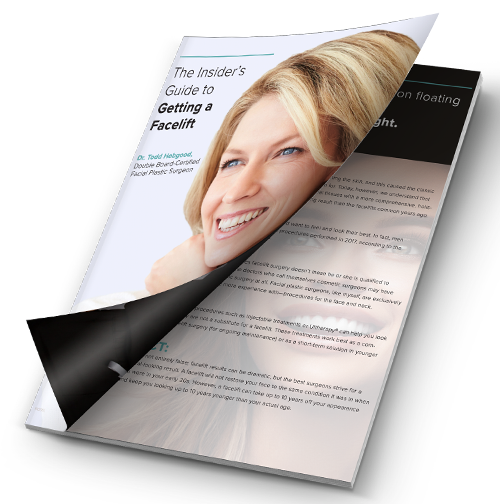Before undergoing a facelift procedure, you may be curious about how to manage your pain post-op. Although most people describe feeling only mild to moderate pain after a facelift, you can expect your face to feel tight, bruised, and tender for several days.
Below you will find tips to help reduce your pain after surgery, and we provide a general recovery timeline so you know what to expect.
How Can I Manage My Pain After a Facelift?
1. Rest
The first few days after your procedure are crucial, and resting during this time allows your body to begin healing. When in bed, prop yourself up with pillows under your upper back and shoulders (but not behind your head) and be sure to wiggle and move your feet a couple of times per hour. Many people find that sitting and sleeping in a recliner is the easiest option. It is important to check with your surgeon about the activities that are allowed during the first days of your recovery.
2. Fill Your Medication
Before you undergo your procedure, you will be prescribed pain relievers and you will probably need to purchase antibiotic ointment and hydrogen peroxide. These medicines will help prevent infections and reduce your pain. Make sure to get your medications ready as soon as possible, preferably before your surgery, so they can be on hand when needed. Check with your surgeon about any vitamins or other medications needed to ensure you are able to maintain healthy, beautiful results.
3. Avoid Heavy Lifting
By lifting something heavy, you may put pressure on the wounds. This may result in swelling, bleeding, and wound opening. Avoid bending or lifting anything for the length of time described by your surgical team.
4. Keep It Cool
Wrap a cold compress (frozen peas and corn work well) with a clean towel or cloth and apply it to your face for 10 to 20 minutes every couple of hours. Cold packs can help lessen swelling and discoloration and ease discomfort. Talk to your surgeon about proper applications and at which stages you may use a cold compress.
5. Minimize Head & Facial Movement
Too much head turning or neck bending can affect the sutures and wounds. Try to restrict this movement as much as possible at the beginning of your recovery to minimize the pain associated with these wounds.

A Must-Have for Facelift Patients
"The Insider's Guide to Getting a Facelift" is the definitive e-book that distinguishes facts from myths and describes the journey of a facelift patient with engaging content and easy-to-understand illustrations.
Double board-certified facial plastic surgeon Dr. Todd Hobgood is one of the leading facelift experts in the U.S., and he's drawn on years of experience to create this Insider's Guide.
Dr. Hobgood's Insider's Guide describes:
- Why modern facelift techniques create results that look natural
- Who is a good candidate for a facelift
- What the difference is between a full and a mini facelift
- When you can expect to see friends socially after a facelift
Submit the form below to receive our free eGuide as part of a short series of emails on Facelift.
Fields marked * are required.
Recovery Timeline
Often, knowing what to expect during recovery can help you better manage your discomfort. When you’re feeling post-surgical pain, for example, it can help to know when to expect the tide to turn. While experiences vary, here’s a general recovery timeline that can help you prepare.
Day After Surgery: You will experience normal feelings of tenderness, discomfort, tightness, and swelling. During your follow-up appointment, your dressings and drainage tubes will be removed.
Day 3 to 4: Bruising and swelling are at their peak on the third and fourth day after surgery. Try to rest as much as possible, but you can move around the house as you wish.
End of Week One: Swelling will start to go down but may linger for several weeks. You may no longer need prescription pain medication at this time.
Two Weeks: You will begin to see that swelling and bruising have diminished significantly. You may start to integrate makeup to help you feel more comfortable in social settings. You can return to light activities and work if the job is not too strenuous.
One Month: You should see your results at this point, and you’re mostly able to return to your normal activities. You may experience residual swelling, tingling, and tightness that will go away as the weeks and months pass. Your incision lines will begin to fade over the course of the following months.
Have Questions?
Do you want to learn more about what to expect after your facelift? Request a consultation using our online form or call us at (480) 214-9955. Men and women visit my practice to experience expert care, with a team focusing only on facial rejuvenation. I have completed more than 1,000 facelifts throughout my career and guided my patients from a thorough consultation to a complete recovery.


Experiencing severe pain,shooting shock pain,can’t open mouth properly,can’t chew,2 weeks after mini face and neck lift.Predominantly on left side under jaw bone.
That sounds a bit unusual to me. I would contact your surgeon to describe your experience and get his or her opinion. Hope you feel better.
The two weeks following my procedure were very difficult. I slept and cried mostly. At week 4 I began to see what was happening and it was very exciting. I think I cried in my sleep a few times. I would do it all over again to have this terrific outcome.